Check out my new analytics case study, with highlights from almost three years working with the charity Tommy’s.
Charity case study: Tommy’s
- Post author By Daniel Robertson
- Post date April 13, 2023
- No Comments on Charity case study: Tommy’s


Check out my new analytics case study, with highlights from almost three years working with the charity Tommy’s.

With much fanfare, Google have launched Google Analytics 4 (GA4) and rebranded Looker Studio. They’ve also seen fit to destroy the most simple, established way to create custom reporting dashboards with these tools.
Cue facepalms for analysts and marketers alike. Let’s try to get our data working positively again.

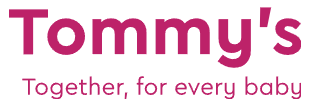
Tommy’s is a charity organisation committed to saving babies’ lives. We fund pioneering research and support families through every part of the pregnancy journey.
Tommy’s has been a core analytics client of mine since 2020. Like most large non-profits, they have a wide range of digital products supporting diverse activities. With one of the UK’s most visited charity websites – tens of thousands of daily visitors to the main site alone – there is a wealth of data to organise and make sense of.
Working closely together, we have delivered reliable data analytics leading to actionable insight. This spanned the launch of a new website in 2020 through to ongoing monitoring, evaluation, and optimisation of Tommy’s activities. Our work together has covered several high-profile websites, apps, campaigns, and digital channels. I have brought a wide range of skills and knowledge to these projects, while constantly learning and adapting to support the highest quality results.
Work delivered includes:
Daniel has been invaluable in helping us to translate often complex and confusing data into meaningful insights and opportunities, in order to continually improve our websites and apps.
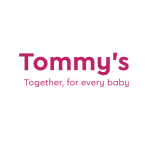
We have carried out several pieces of “deep-dive” analysis across Tommy’s website: detailed data analysis looking at many aspects of web content and user conversion. I am always keen for analysis to present opportunities for improvement, which could relate to UX, content, or communications driving traffic to the site.
Our deep-dive analysis work has accelerated in recent times, feeding directly into Tommy’s strategic web development roadmap. It also provides a sound basis of quantitative insight – and inspiration! - for our CRO programme.
We have helped to evaluate the overall performance of Tommy’s website, focusing on traffic profiles, user journeys, and a range of key outcomes across the site. As well as this broad analysis, we have delivered granular insight into specific areas, like the donation process and Tommy’s popular pregnancy tools.
Most recently, we analysed the performance of Tommy’s new Miscarriage Support Tool in depth. The Miscarriage Support Tool uses an algorithm developed by the University of Warwick and is based on data collected from Tommy’s National Centre for Miscarriage Research. Our insights fed directly into development improvements and enhanced recruitment for user research, receiving positive feedback from within Tommy’s.
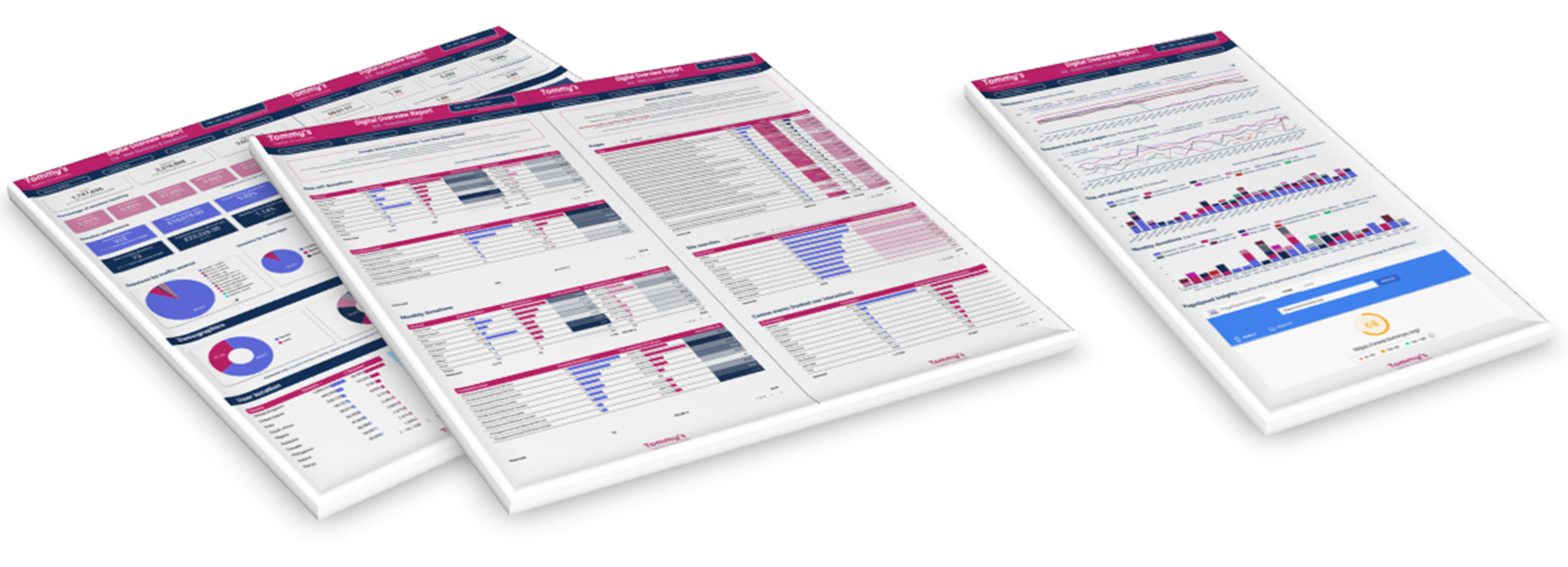
A core specialism throughout my career has been conversion rate optimisation (CRO). Through structured AB or multivariate tests – randomised control trials - we can get true “cause and effect” insight on website changes.
I have brought years of successful CRO experience to Tommy’s, helping them to:

We gained momentum in our CRO programme across 2021-22. Our first major test was a success: we trialled two popup variants on Pregnancy Hub pages, asking users to sign up to pregnancy support emails. We had to ensure that the popup was not shown at inappropriate times, such as on pages relating to baby loss. We also did not want to damage the overall user experience and cause abandonment from the site.
The test resulted in a clear winning popup variant, with over four times the email signup conversion of the control (gaining hundreds of extra signups over the test period). We also increased the marketing opt-in rates from completed signups, and improved overall website engagement rates, making this test a resounding success for positive uplift.
Next, we focused heavily on optimising the website donation process. We carried out several tests, starting with introducing an inline donation widget to high-traffic pages then moving on to testing donation popups across different site sections. We also completed iterative rounds of testing on the donation form prompts, aiming to find optimal values and understand the behavioural economics underpinning donor choices.
Our tests so far have been extremely useful. They have either given us direct conversion uplift or helped increase our understanding of user behaviour and guide development priorities.
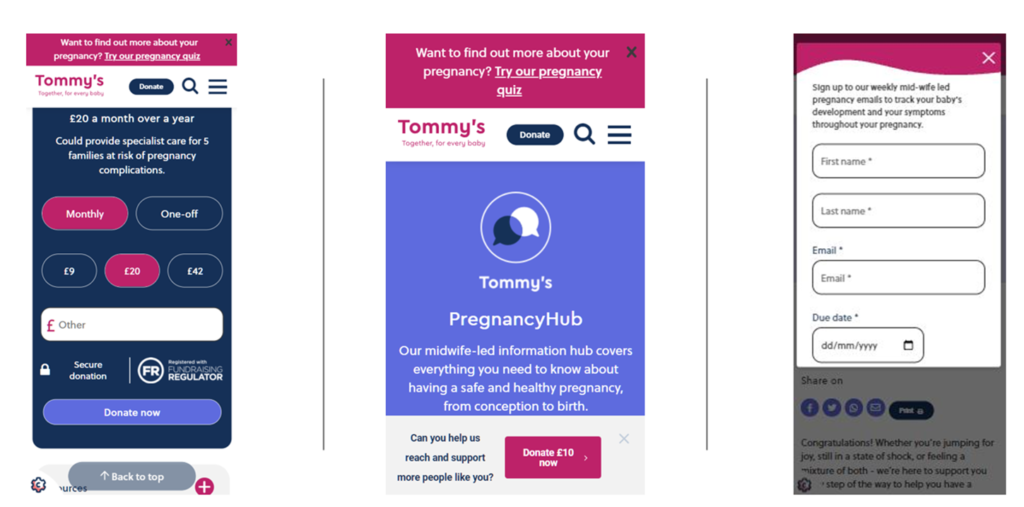
All data analytics needs a good implementation at its heart. This is particularly true for Tommy’s: several websites, apps, and platforms generate a huge continuous stream of visits, interactions, and conversions.
I was fortunate to come on board several months before the launch of Tommy’s new website in 2020. This enabled us to think through solutions, map out what we wanted to track (and why), and work closely with web developers. I advocated a clean, modular, consistent approach using the Google suite of products. Central to this was using Google Tag Manager (GTM) to help us deploy analytics and marketing tags with relative ease. I proposed a custom data layer for rich information capture – for areas like donation transactions and marketing opt-ins - briefing developers and providing thorough feedback to achieve this. We also integrated Google Optimize across the main website for CRO experiments and personalisations.
Initially, I set up a comprehensive Google Universal Analytics (UA) solution for Tommy’s main website via GTM. We have since extended the solution to several microsites and a mobile app, My Prem Baby. In 2022, we completed a complex rollout of the new Google Analytics 4 (GA4). I created a comprehensive GTM/GA4 solution design, which doubles as a handy reporting reference. I have also facilitated the setup of other tools, such as Wisepops to help us AB test website popups.
I am stepping back from hands-on implementation but have left solid foundations and practices in place for the future. From the beginning, I strove to explain to Tommy’s what we were doing and why, so that the solution did not become a “black box”. In reporting and analysis, I clearly outline caveats and limitations with the data, which ultimately aids understanding and insight. I have demonstrated various tools and technical concepts to Tommy’s and their consultants over the course of our work, to ease the handover of the analytics setup.

I am continuing to work closely with Tommy’s, with renewed focus on insight and optimisation.
My strategic aim is to use organisations’ existing data and capabilities to their fullest potential. Working with Tommy’s and their developers, we hope to roll out many more CRO tests and website enhancements in 2023.
Our overarching objectives are to improve the user experience and support good outcomes for those who use Tommy’s services and content. Positive social impact is what drives me as an analytics specialist working with non-profits; I’m pleased to be a part of achieving this through Tommy’s crucial work.
If you'd like to discuss how I can help your charity with data analytics, you can find me on LinkedIn, or email me at [email protected]

New case study on a comprehensive, long-term analytics project with Vepple – a rich content platform for higher education student recruitment.

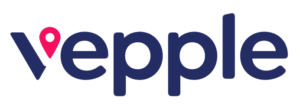

Vepple is an always on virtual experience platform created specifically for Higher Education student recruitment, with a focus on personalisation to increase conversion.
In developing and launching a virtual experience platform for several universities, Revolution Viewing identified the need for structured data analytics to support its growth.
They commissioned me to design and implement web analytics, assist with reporting, and uncover deeper insights about user engagement and conversion.
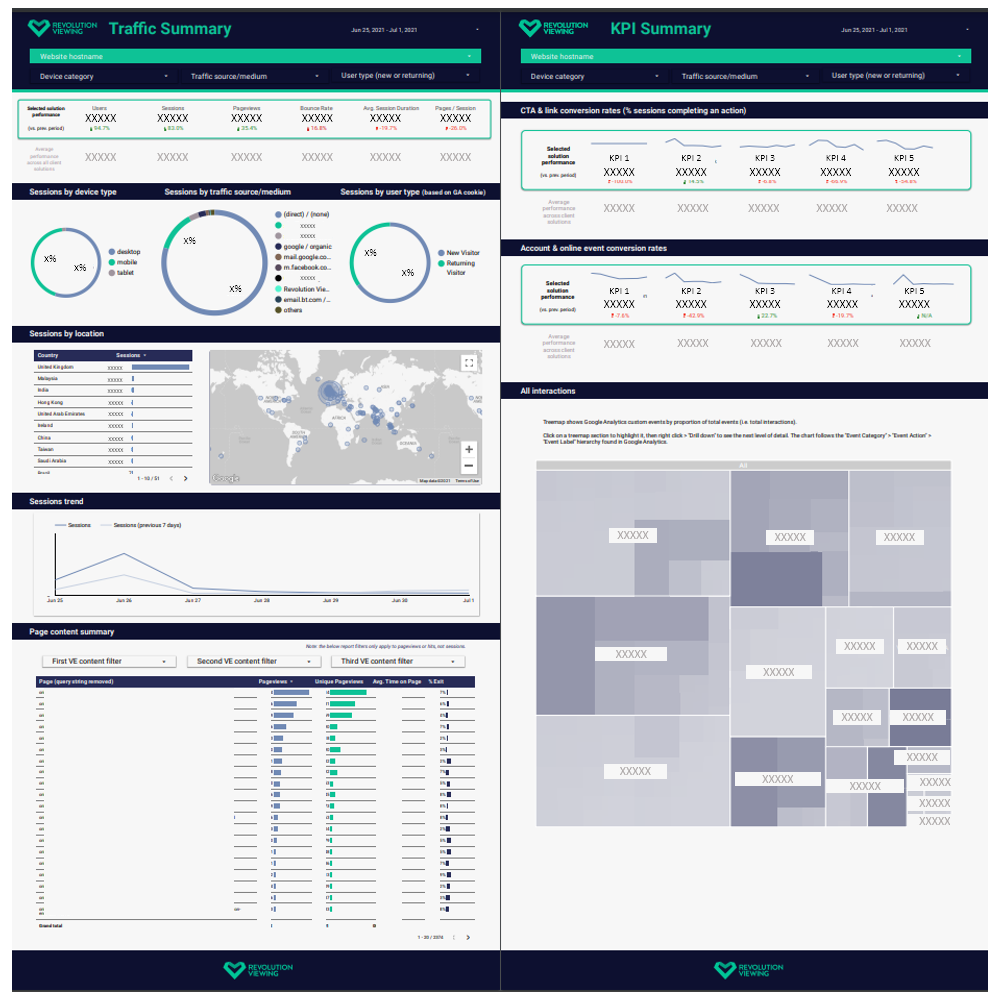
Working with Daniel has been absolutely brilliant – he is structured, knowledgeable and has exceptional attention to detail. He’s also a lovely bloke which always helps!
Daniel helped us to understand how students are using our new university virtual experience platform, Vepple, and in turn, prove to our clients that the platform is delivering an acceptable ROI through an easy-to-use Looker Studio report. The team have really enjoyed working with Daniel and look forward to building on our working relationship as our platform grows.

The project began with initial strategic immersion. We reviewed Vepple’s planned features and user journeys, alongside Revolution Viewing’s client strategy and the analytics for previous iterations of the virtual experience. This helped to understand the platform and main objectives more deeply.
The next step was to take this strategic information and produce a measurement framework.
The framework broke down the student’s experience of exploring universities into key “funnel” stages, as they related to Vepple and the university in question:
Against each stage, we defined KPIs, supporting metrics, user segments, and dimensions of interest. Most metrics were directly relevant to the Vepple platform, though the measurement framework also spanned different digital platforms and onward conversion journeys.
The purpose of the measurement framework was to ensure that our analytics solution captured all possible data that was strategically relevant, while keeping us focused in our data collection efforts. The measurement framework is also intended as a point of reference for ongoing monitoring and evaluation of the platform.

With a measurement framework agreed, we then moved on to the task of designing and implementing Google Analytics for a dynamic platform rich in different features and types of content.
First, we translated the measurement framework and existing reporting requirements into a comprehensive solution design. This document laid out all the precise parameters for our GA setup and doubled as an evolving reference/specification. The solution covered Universal Analytics and GA4, with setups for both Revolution Viewing and for client universities’ own data collection. This meant four complex GA solutions developed in parallel.
Once the solution design was completed and signed off, working closely with Revolution Viewing’s developers we moved into designing and briefing a data layer and Google Tag Manager setup. This would serve as the foundation for all our analytics data collection. We also had to ensure that we respected users’ cookie consent options.
We then implemented a wide range of GA tags to collect data for all key user interactions, content views, and conversions. As Vepple is constantly evolving, over time we went through several rounds of analytics tracking updates to ensure that we had a correct and up-to-date set of reports.
We also set up a daily export from Vepple’s master GA4 property to a Google BigQuery project. This helps to ensure that granular analytics data will be fully available in future and can be queried flexibly on demand.
Once we had the GA data flowing, there was a need to surface basic performance data and trends in a clear dashboard.
We used Google Looker Studio to create a bespoke, dynamic dashboard, showing KPI performance and with some drill down into supporting metrics. The dashboard could be filtered by different universities’ Vepple experiences, or other parameters such as user content selections, device types, traffic sources, etc.
We also included the ability to allow individual university performance to be easily benchmarked against the aggregate performance of all universities using Vepple.
With good foundations in place, we were able to carry out pieces of deeper analysis at key strategic points.
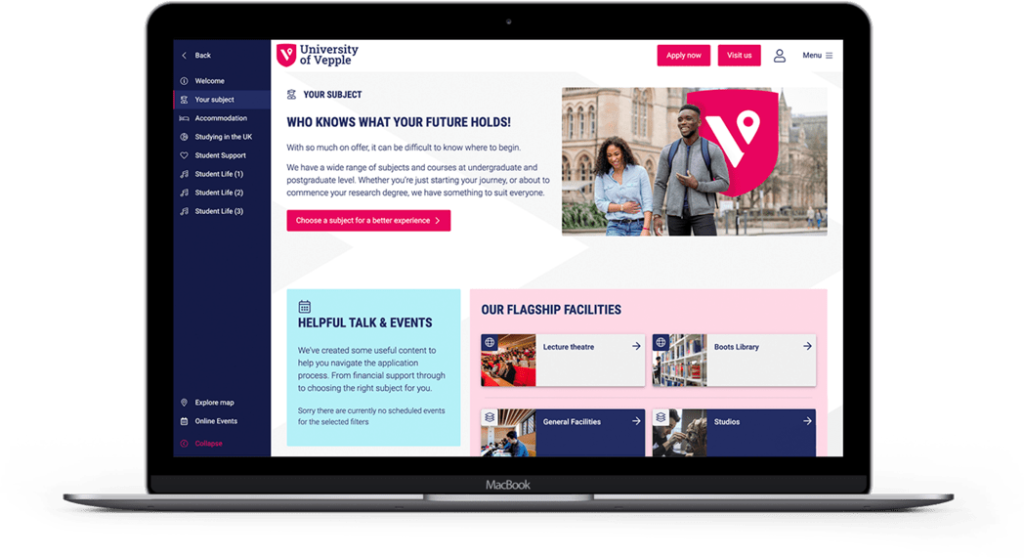
Once we had a few months of data, we completed a general review of Vepple’s performance in terms of engagement and conversion. We looked at traffic trends, performance around key events such as university open days, audience profiles and segments, and conversion rates for important interactions and conversion metrics. This analysis helped understand if there were any issues with the platform, begin to identify opportunities for improvements, and develop some further analysis questions.
Next up was a “research vs. reality” analysis to support a presentation by Revolution Viewing to university clients. This analysis looked at some specific insights from qualitative research, using our quantitative data to compare actual user behaviour to stated preferences and desired features. We also broke down Vepple engagement and content data by several detailed segments to provide additional information to university partners.
Our most recent analysis looked at how user engagement and conversion varied by use of content filters. These content filters are a key feature of Vepple, allowing prospective students to personalise their virtual experience by level of study, subject area, etc.

We have completed a full programme of analytics work in designing, setting up, and using rich interaction data for Vepple. The data and insights have been well used, offering Revolution Viewing a strong platform to monitor performance and deliver ongoing improvements, as well as highlight the benefits of using Vepple to deliver content.
In my view, Revolution Viewing have been an ideal client. They are clearly experts in their field, know their audience, have a deep knowledge of technology, and are great to work with. Crucially, they understand the value of analytics and how to get the most from their data. This provides great added value to universities and prospective students alike.
If you'd like to discuss how I can help your organisation with data analytics, you can find me on LinkedIn, or email me at [email protected]